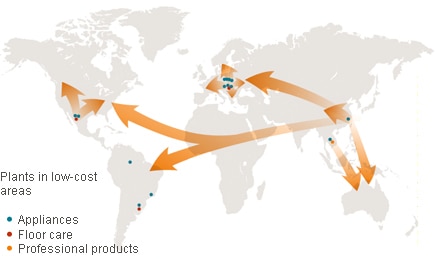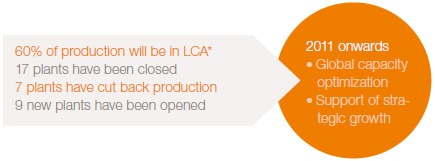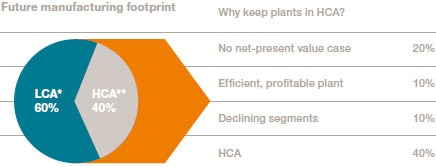Increased investment in product development and brand communication presupposes lower production costs and less capital tied up in manufacturing. The extensive restructuring program and the greater proportion of procurement from low-cost areas (LCA) of recent years must be viewed against this backdrop. Now, the objective is global optimization of operations to reduce costs further and to increase the growth rate.

Electrolux currently has production facilities in 16 countries. Modern, highly-productive plants have been built in Asia, Mexico and Eastern Europe. In addition to producing innovative high-quality products for the Australian, North American and Western European markets, these plants also supply nearby growth markets with competitive products. In 2010, production units were acquired in the Ukraine.
Competitive manufacturing footprint
The need for cost-efficient manufacturing has become increasingly important due to globalization and the emergence of manufacturers from low-cost areas. In 2011, Electrolux will complete the extensive restructuring program commenced in 2004, and on its conclusion, Electrolux will have a competitive production structure with modern and efficient production units, all of which apply the same high labor and environmental standards, across the globe. Savings realized by the program are estimated to amount to approximately SEK 3.4 billion with a full yearly effect from 2013. Approximately 60% of the Group’s household appliances will be manufactured in low-cost areas that are near rapidly-growing markets for household appliances. During 2010, Electrolux acquired a washing-machine plant in the Ukraine and signed a preliminary agreement to acquire the Egyptian Olympic Group, a leading manufacturer of household appliances for the North African and Middle Eastern markets.
Program for more efficient production
In parallel with the move of production to low-cost areas, the Group has implemented various programs to increase the efficiency and quality of products and production. The Electrolux Manufacturing System (EMS) is built on various tried and tested production improvement methods, developed internally in the Group and externally, and is a program that has been implemented with great success in all Electrolux plants. By continuous improvement, EMS targets employee safety, product quality, costs and environmental impact. The success of EMS has led to the program being linked together with other larger Group investments and projects, including procurement and product development.
Lower costs and more efficient production have resulted in Electrolux being profitable despite low utilization of capacity. Only about 20% of the Group’s total costs are fixed over time, which provides the flexibility to adapt the business to changes in demand.
Manufacturing will optimize capacity utilization and support strategic growth

* LCA, plants in low-cost areas.
Greater procurement levels from low-cost areas
A number of activities have been implemented to lower costs for materials, which account for just over half of the Group’s total costs. The proportion of procurement from low-cost areas increased from 30% in 2004 to approximately 62% in 2010 and is expected to reach approximately 70% in a couple of years. Since procurement from Asian suppliers is increasing, an Asian procurement organization has been established. The aim is to strengthen the Group’s global ability to interact with suppliers, conduct quality controls and responsible sourcing and increase efficiency.
Production remains in high-cost areas
There are still production units that must remain in high-cost areas (HCA). The production of hobs and ovens for the built-in segment in Europe must be near the end-market due to the advanced technology utilized and high transportation costs. Proximity to end-market is also important for the profitability of refrigerators, since these products are bulky and, therefore, expensive to transport. In addition, labor costs form just a small portion of total production costs. Products intended for professional users are always manufactured close to the market in which they are sold. Smaller products such as vacuum cleaners are inexpensive to transport long distances and all production of the Group’s vacuum cleaners is in low-cost areas.

* LCA, plants in low-cost areas.
** HCA, plants in high-cost areas.
